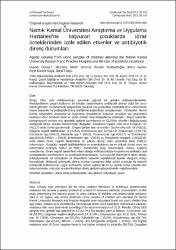| dc.contributor.author | Güneş, Hayati | |
| dc.contributor.author | Donma, Mustafa Metin | |
| dc.contributor.author | Nalbantoğlu, Burçin | |
| dc.contributor.author | Aydın Kurç, Mine | |
| dc.contributor.author | Kaya, Ayşe Demet | |
| dc.contributor.author | Topçu, Birol | |
| dc.date.accessioned | 2022-05-11T14:37:11Z | |
| dc.date.available | 2022-05-11T14:37:11Z | |
| dc.date.issued | 2013 | |
| dc.identifier.issn | 1305-0028 | |
| dc.identifier.issn | 1305-0028 | |
| dc.identifier.uri | https://app.trdizin.gov.tr/makale/TVRjMk1qZzVPUT09 | |
| dc.identifier.uri | https://hdl.handle.net/20.500.11776/8609 | |
| dc.description.abstract | Amaç. İdrar yolu enfeksiyonları, çocukluk çağında sık görülen enfeksiyonlardandır. Antibiyotiklerin yaygın kullanımı ile beraber bakterilerdeki antibiyotik direnci ciddi bir sorun haline gelmiştir. Çalışmamızda bölgemizde çocukluk yaş grubundaki hastalarda idrar kültürlerinde üreyen bakteriler ve antibiyotik direnç oranlarının araştırılması amaçlanmıştır. Yöntemler. Namık Kemal üniversitesi Araştırma ve Uygulama Hastanesine başvuran çocukluk yaş grubundaki hastaların idrar örnekleri kanlı ve eozin metilen blue besiyerlerine ekilmiştir. Üreyen bakteriler konvansiyonel ve/veya yarı otomatik testlerle tanımlanmış ve CLSInin önerileri doğrultusunda antibiyotik direnç oranları belirlenmiştir. Bulgular. Gönderilen toplam 1003 idrar örneğinin 127 (%12,7)sinde üreme gözlenmiştir. Üreyen bakteri sayı ve oranları: Escherichia coli: 66 (%52,0), koagülaz negatif stafilokoklar: 14 (%11,0), Enterococcus spp: 14 (%11,0), Proteus spp: 10 (%7,9), Citrobacter spp:7(%5,5), Klebsiella spp 7 (%5,5), Pseudomonas spp 6(%4,7) ve Enterobacter spp:1(%0,8) MRSA: 1 (%0,8), Enterobacter spp: 1(%0,8) ve Morganella morganii: 1(%0,8)dir. İzole edilen Gram negatif bakterilerde en yüksek direnç oranı ampisiline karşı (%65,2) bulunmuştur. Koagülaz negatif stafilokoklarda ve enterokoklarda ise en yüksek direnç oranı ise eritromisine (sırasıyla %64,3 ve %85,7 oranlarında) karşı bulunmuştur. Sonuç. Çalışma sonuçlarımız, Gram negatif bakterilerin etken olduğu enfeksiyonlarda imipenem ve amikasin, oral preparatlardan nitrofurantoin ve amoksisilin/klavulanatın; Gram pozitif bakterilerin etken olduğu enfeksiyonlarda ise teikoplanin ve linezolidin tedavide seçilebilecek ajanlar olduğunu ortaya koymaktadır. Bölgesel antibiyotik direnç oranları konusunda bilgi sahibi olunması ile ampirik antibiyotik kullanımında, uygun antibiyotik seçimi sağlanacak ve bu sayede ortaya çıkacak olan tedavi sorunları, mali yük ve antimikrobiyal direnç gelişimi gibi problemler engellenecektir. | en_US |
| dc.description.abstract | Aim. Urinary tract infections are the most common infections in childhood. Antimicrobial resistance has become a serious problem as a result of extensive antibiotic comsumption. In this study determining the bacteria grown in urine cultures of children and antimicrobial resistance rates in our region, was aimed. Methods. Urine samples of children who attended the Namık Kemal University Research and Practice Hospital were inoculated blood and eozin metilen blue agar plates. Isolates were identified by conventional and/or semi automated methods and antibiotic resistance rates were determined according to the recommendations of CLSI. Results. Of the 1003 samples sent, growth was obtained in 127(12.7%).The isolates were as follows; Escherichia coli: 66 (52.0%), coagulase negative staphyococci: 14 (11.0%), Enterococcus spp: 14 11.0(%), Proteus spp: 10 7.9(%), Citrobacter spp:7(5.5%), Klebsiella spp 7 (5,5%), Pseudomonas spp 6(4.7%), Enterobacter spp:1(0.8%) MRSA: 1 0.8(%), and Morganella morganii: 1 (0.8%). The highest resistance rates of Gram negative bacteria had higher resistant to ampicilin (65.2%). Coagulase negative staphylococci and enterococci had higher resistant to erithromycine (respectively 64.3%, and 85.7%). Conclusion. The results of our study showed that, in infections caused by Gram negative bacteria imipenem and amikacin, from oral preparats nitrofurantoin and amoksisilin/clavulanate and in infections caused by Gram positive bacteria teichoplanin and linezolide are the agents that can be used in therapy. Knowledge of the regional resistance patterns can lead the selection of appropriate antibiotic in empiric therapy and as a result of this, management problems, financial problems and the development of antimicrobial resistance can be prevented. | en_US |
| dc.language.iso | tur | en_US |
| dc.rights | info:eu-repo/semantics/openAccess | en_US |
| dc.subject | Biyoteknoloji ve Uygulamalı Mikrobiyoloji | en_US |
| dc.subject | Tıbbi Laboratuar Teknolojisi | en_US |
| dc.subject | Mikrobiyoloji | en_US |
| dc.subject | Farmakoloji ve Eczacılık | en_US |
| dc.title | Namık Kemal Üniversitesi Araştırma ve Uygulama Hastanesi'ne başvuran çocuklarda idrar örneklerinden izole edilen etkenler ve antibiyotik direnç durumları | en_US |
| dc.title.alternative | Agents isolated f rom urine samples of children attended the Namik Kemal University Research and Practice Hospital and the rate of antibiotic resistance | en_US |
| dc.type | article | en_US |
| dc.relation.ispartof | Cumhuriyet Tıp Dergisi (ELEKTRONİK) | en_US |
| dc.department | Fakülteler, Tıp Fakültesi, Dahili Tıp Bilimleri Bölümü, Çocuk Sağlığı ve Hastalıkları Ana Bilim Dalı | en_US |
| dc.identifier.volume | 35 | en_US |
| dc.identifier.issue | 1 | en_US |
| dc.identifier.startpage | 1 | en_US |
| dc.identifier.endpage | 8 | en_US |
| dc.institutionauthor | Güneş, Hayati | |
| dc.institutionauthor | Donma, Mustafa Metin | |
| dc.institutionauthor | Nalbantoğlu, Burçin | |
| dc.institutionauthor | Aydın Kurç, Mine | |
| dc.institutionauthor | Kaya, Ayşe Demet | |
| dc.institutionauthor | Topçu, Birol | |
| dc.identifier.trdizinid | TVRjMk1qZzVPUT09 | en_US |



















